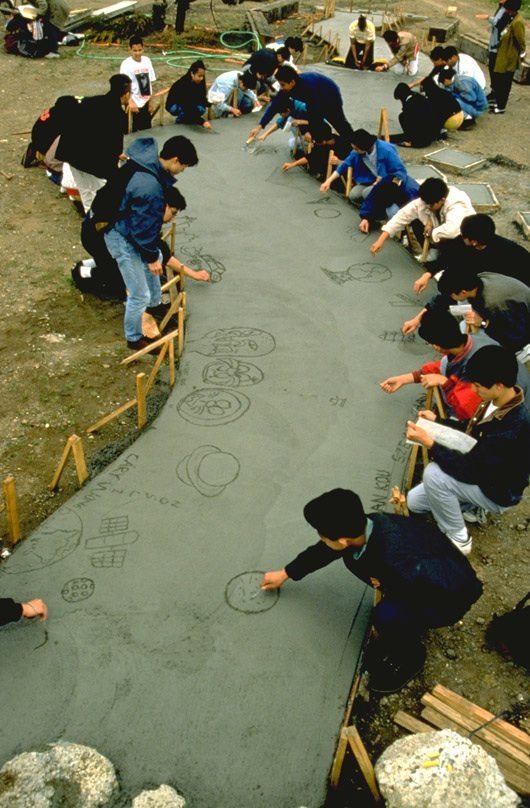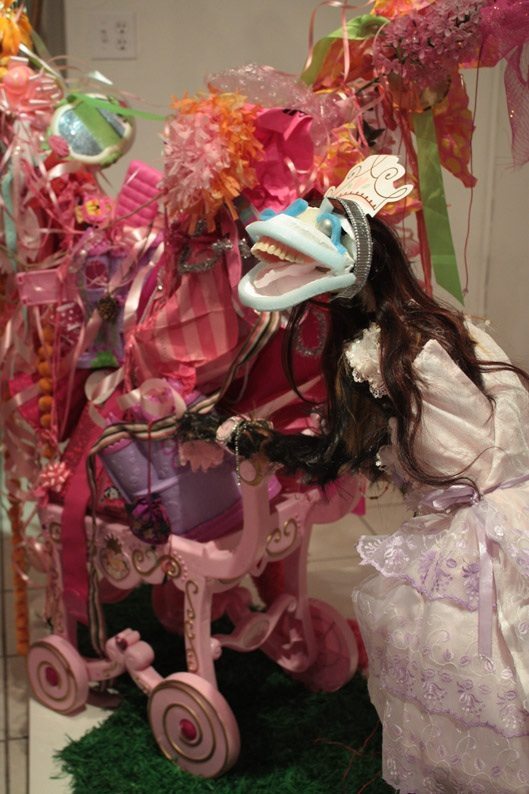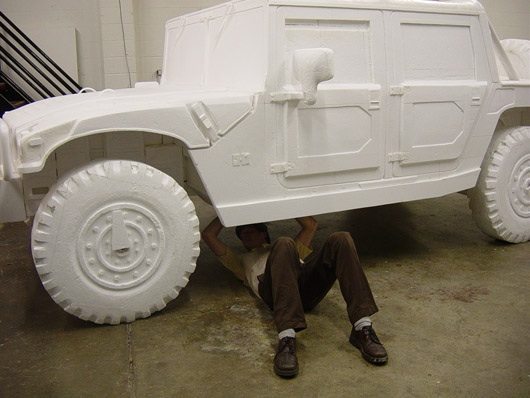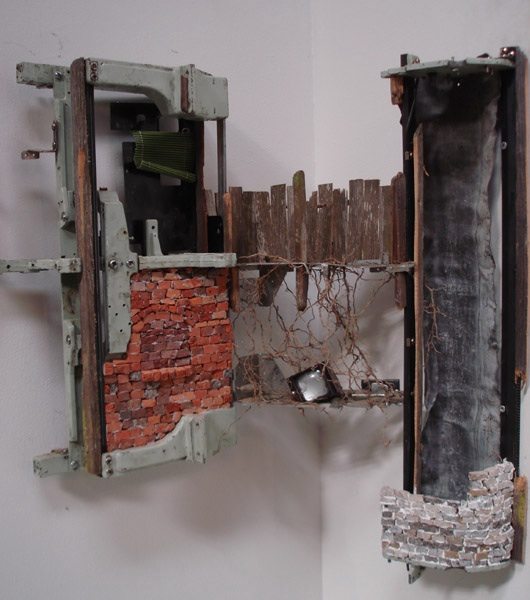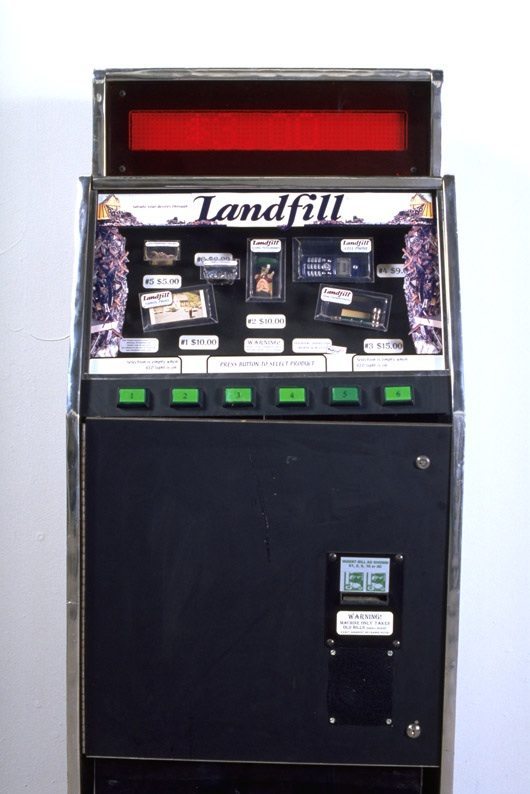Location: San Francisco CA
INTRODUCTION
LOCATED AT THE SAN FRANCISCO Solid Waste Transfer and Recycling Center, the Recology San Francisco Artist in Residence Program is a unique initiative which provides artists with studio space, a stipend, and access to materials in the public dump with which to make art. The program was conceived twenty-one years ago by Jo Hanson, a San Francisco artist and activist, and co-founder of WEAD. Though Hanson died in 2007, her commitment to environmental issues lives on in the work of the more than one-hundred artists who have participated in the program since its founding.
The existence of the Artist in Residence Program can be attributed largely to the progressive nature of the Bay Area, and the unique collaborative relationship that exists between the City of San Francisco and Recology, its recycling/composting/garbage service provider. San Francisco’s citizenry, and in turn its government, prioritizes environmental conservation and advocacy as demonstrated by the community’s recognition this year as the Greenest City in North America in a study that ranked twenty-seven majors cities on environmental policies across nine categories. In collaboration with Recology, an employee-owned company that shares a commitment to environmentalism and often takes an unorthodox approach to the business of resource recovery, the City now hopes to achieve ‘Zero Waste,’ by 2020.
Zero Waste is defined as the diversion of all materials from landfill, and though this seems like a lofty goal, the fact that San Francisco already diverts 77% of materials away from landfill indicates that Zero Waste is not as improbably as one might think. Outreach and education is a huge factor in achieving this goal, and today the Artist in Residence Program is the cornerstone in an education program that includes classroom lessons on ‘how to recycle and compost in San Francisco’ and visits to San Francisco’s recycling facility and transfer station (where garbage goes before heading to landfill). More than 5,000 children and adults attend tours each year which also include a visit to the art studio to meet artists-in-residence. Talking with the artists and seeing what can be created from what someone else considered trash is a highlight of tours and can have a profound effect on how visitors subsequently think about their own consumption practices.
I. BACKGROUND
THE FOUNDING OF THE ARTIST IN RESIDENCE PROGRAM stemmed from the work of Jo Hanson and came at the time that San Francisco was initiating city-wide curbside recycling. Hanson, an artist who came to prominence in the 1970s, had begun a personal practice of sweeping in front of her Lower Haight neighborhood home. She gathered found materials into large books, bringing meaning to the litter that included everything from love letters to hypodermic needles and which reflected the history and day to day life of her community. Soon Hanson began organizing city-wide street sweeping campaigns and tours of illegal dumping sites in the City, and ultimately an exhibition at San Francisco City Hall. Once her work was brought to the attention of City officials she was invited to Recology San Francisco (then known as Sanitary Fill Company) to see where the things she was sweeping up were going. After seeing the wealth of materials there, she recognized the value these items could have to artists and proposed the idea of the residency program.
Hanson’s proposal coincided with the establishment of curbside recycling in San Francisco, resulting from the 1989 state law AB 939. The law required all jurisdictions in California to divert at least fifty-percent of their waste from landfills by the year 2000. In San Francisco, city government worked with Recology to create informational ads and brochures about recycling, develop classroom presentations, and organize tours of recycling plants. The goal was to teach people how to use curbside recycling bins and to encourage source reduction in order to promote a general awareness of how recycling helps protect the environment. The Artist in Residence Program was the most innovative element of the education plan.
II. ARTIST RESIDENCIES AND EMERGENCE OF SOCIAL PRACTICE
THE FIRST ARTISTS TO HAVE RESIDENCIES AT THE FACILITY, sculptors William Wareham and Jim Growden, created large-scale, abstract works in steel which are important pieces that still stand in the program’s sculpture garden and gallery. These works helped initiate a theme of the program—that art from recycled materials doesn’t have to be confined to mixed-media sculpture or folk art-like forms.
While fine art sculpture, painting, and photography, among other mediums, has continued to be made by residency artists, beginning with Remi Rubel in 1991, a model of social practice within the dump residencies also began to emerge. Rubel’s work included a collaboration with members of the Youth in Action Corps on a large-scale bottle cap-covered freestanding mosaic mural which today stands outside the Recology San Francisco offices.
Other artists in the early years of the program were fiber artist Estelle Akamine and Graecian Goeke. Akamine’s elegant black and white garments woven from materials including computer ribbon tape and mini blinds, were worn at the 1993 Black and White Ball in San Francisco to advocate for environmental awareness. Goeke worked with kindergarten, elementary and junior high school students in 1997 on collaborative theatrical and musical performances that utilized costumes and instruments they had made from recycled materials.
Most notable is Susan Leibovitz Steinman’s 1991-92 design for the Recology Sculpture Garden, a three acre drought tolerant landscape of native and recycled plant life where Recology artists exhibit their outdoor sculpture. Central to the Garden is her collaborative installation, The River of Hopes and Dreams. In addition to proposing, designing, and facilitating the creation of the garden, Steinman worked with seventy-five students from nearby Phillip and Sala Burton High School. The students drew their own images and words expressing future hopes into a river-like path flowing from a salvaged concrete mountain. Plants embedded in the mountain have reclaimed the space today. The garden is a stop for all tours of the facility with more than 5,000 visitors each year.
III. IMPACT OF RESIDENCY EXPERIENCE ON ARTISTS’ WORK
THROUGH THE YEARS ARTISTS HAVE MADE WORK WITH overt or more subtle political or environmental messages. For many, this is simply a part of their practice, for others their residency experience is a catalyst. In many ways working at the dump politicizes everyone, as any artwork created from recycled materials is, in a sense, a political act—a statement that creativity need not be bound by commerce. It is virtually impossible to scavenge for weeks for art materials in the Public Disposal and Recycling Area and not be profoundly impacted by the overwhelming quantity of items than pass through and not have a greater understanding of the environmental damage inflicted by our culture of consumption. So for many artists it has been impossible not to be moved to make work that addresses these issues.
Marta Thoma (1993), Banker White (2000), Gaza Bowen (2001), Donna Keiko Ozawa (2001), Sharon Siskin (2004), Hector Dio Mendoza (2005), Sirron Norris (2005), and David Hevel (2009) are just some of the artists who created bodies of work during their residencies that included pieces that addressed consumption practices and environmental concerns, and in some cases broader issues including race, gentrification, and gender roles.
When applying to the program, artists are asked to submit a proposal for what they intend to do during their residency, but often by encountering new materials artists move in different directions.
Artist-in-residence Andrew Junge (2005) made a range of work including small sculptures and a personal journal with daily drawings of his residency experience. However, he became particularly aware of the large amount of Styrofoam that passed through the facility and knowing the incredibly negative impact the material has on the environment, looked for a sculptural analogy. His Styrofoam Hummer H1 (low mileage, always garaged), is a life-size Styrofoam version of the then popular gas-guzzling vehicle. Visually impressive, the work uses humor and irony to address issues of our dwindling oil supply and fossil fuel’s use for both the powering of vehicles and the creation of plastics such as Styrofoam.
Though more subtle in its environmental message, a theme that has appeared in the work of more recent artists explores disaster scenarios, or visions of a post-apocalyptic world. Josh Short’s (2010) Mad Max-style mash-ups of electronics, household items, and objects from popular culture resulted in clever artworks that might serve as provisions or sources of entertainment for inhabits of a fall-out shelter.
James Sansing’s (2009) meticulously crafted, small diorama-like environments present haunting scenes of abandonment. Urban streets are devoid of people, walls crumble, and objects such as televisions and tires are left for vines to cover.
During Scott Kildall’s recent 2011 residency, he assume the persona of a prospector from the year 2049 who is forced to mine former landfills (our contemporary garbage) for materials to make devices to aid in his survival. Video reports and written ‘missives’ from the future were exhibited along with built invention such as the Sniffer, which combines a weedwacker with a dental exam dummy head, enabling the ‘sniffing out’ of toxic dangers. While humor is a definite component of Kildall’s pieces, implicit in the work of all three artists is the concept of a looming human-made disaster and the possible realization of our darkest ecological nightmares.
IV. FOCUS ON THE WORK OF ROBIN LASSER, PACKARD JENNINGS, BILL BASQUIN, & SUZANNE HUSKY
Robin Lasser
THE ARTIST IN RESIDENCE PROGRAM WAS ESTABLISHED to support, professional, career-level artists, and that continues to be its focus. However, beginning in 2001, a second, more informal program geared toward graduate and undergraduate art students was implemented and since that time more than twenty students have participated. In 2002, San Jose State University professor Robin Lasser used the student residency program as an opportunity for her class of graduate photography students to expand their practice. The ten students were allowed to move within and photograph the facility, creating site-specific artworks that respond to the complex and varied environment of the San Francisco Solid Waste Transfer and Recycling Facility. Along with her students, Lasser made her own work, and her video and photographs became the installation, Dining in the Dump.
Lasser, who uses art to address cultural, health, and environmental issues, seized the opportunity of working ‘at the dump,’ to explore societal consumption practices. This work paralleled a previous body of work that explored desire, including the desire to shop and consume, however Lasser’s work at Recology adds a new element through the juxtaposition of consumption with its byproduct, waste. Scenes from the video include Lasser standing in the transfer station at a conveyor belt normally used at the facility to sort recyclable materials. In this case snack foods and beverages pass by the artist as she grabs and consumes what she can from the never ending stream. The conveyer belt moves at an increasingly rapid pace, as ambient sounds of equipment in the transfer station grow louder and more overwhelming. The artist compulsively binges and consumes as the scene mimics the never-ending, overwhelming nature of the waste stream. In another segment filmed in reverse, sandwiches fly out of a pit of garbage onto a table. As the top bread slices are removed the words ‘bottomless’ appear within the sandwiches—describing both our hunger to consume and the apparent bottomless pit of garbage. Her students participated in her large scale photo, standing atop mounds of garbage holding six-foot-tall forks made from food. Equating consumer consumption with the physical consumption of food brings a strong, visceral component to the work—a literal consumer-driven nausea.
Packard Jennings
Packard Jennings may be best known for his shopdrop actions which introduced new products, such as the Anarchist Action Figure, to store shelves. Using humor and clever interventionist tactics, Jennings calls attention to the transgressions of corporate, political, and religious institutions, including their environmental offenses. During his 2003 Recology residency which coincided with the height of post 9/11 paranoia, Jennings parodied government surveillance and the color-coded threat level system implemented by Homeland Security. His Terrorist Alert, a five-foot-tall sign reminiscent of a National Park fire danger sign, provided changeable words for the statement ‘Terrorist Alert ___ Today!’ including ‘exaggerated’ and ‘periwinkle.’ A trove of vending machines provided the opportunity for Jennings to provocatively re-commodify dump finds. His Landfill Vending featured items destined for the landfill, repackaged and ready for purchase, and highlighted how quickly the meaning of goods shifts from desired possessions to garbage.
Like Lasser, who involves her students, and sometimes the public, in her art, Jennings’s work is also often participatory, but in his case a participant can be anyone with access to a computer. Available on Jennings’s website are downloadable documents that can be printed out and covertly left in stores, enabling anyone to become a shopdropper. His Pocket Survival Guide is designed to be cut out, folded up, and attached to plastic containers on store shelves. Through step by step illustrated instructions the guide demonstrates how to survive a flood by stringing together plastic household product containers to create a floatation device. With a heavy dose of irony, the guide details how plastic packaging can save us from an ecological disaster brought on by the production of plastics.
Bill Basquin
Bill Basquin was the first artist to address composting during his residency, which was especially timely as his 2009 residency occurred just months before the enactment of mandatory composting laws in San Francisco. Enabling city residents and businesses, such as restaurants, to put food scraps as well as yard waste and food soiled paper in their curbside ‘green bins,’ Recology’s composting program turns these materials into nutrient rich compost that is used on Northern California farms and vineyards.
Basquin came to his residency with the desire to educate the public about composting, and hoped to inspire people to try doing it in their own backyards. As a photographer and filmmaker, Basquin has explored rural life and agriculture in his work, but he is also interested in how to bring elements of rural life into the urban environment. His art practice is intertwined with his personal farming practice, and he is an advocate for urban agriculture, seed exchanges, and nutrient recycling (a.k.a. composting) in the city. His 2008 Soiled was a year-long project in which he photographed the food he grew in his San Francisco community garden.
During his residency Basquin collected food scraps and documented fruits and vegetables as they broke down over time. The resulting photographs are beautiful studies, akin to landscapes, that visually connect the food back to the earth. Basquin also provided opportunities for engagement through the creation of a sensory immersion chamber, Dirt House. A three by three foot redwood box containing compost that participants can sit on, Dirt House allows participants to have a personal and direct encounter with the composting process. The warmth and smell of the box and compost materials, along with the isolation from the sounds and sights outside, allows for a moment of contemplation and a piece of the rural in the concrete yard outside the art studio where the work was installed.
Suzanne Husky
As a youth growing up in France during Francois Mitterrand’s fourteen years as president, Suzanne Husky was shaped by the country’s socialist ideology and the rural environment. Husky’s interests lie in issues of land use, environmental exploitation and our relationship with nature, as well as globalization and how individuals and communities respond to its impact. Her sculptures and installations address serious issues, but often also have a playful or humorous quality that allows viewers to engage on many levels.
Recently Husky has been exploring the contemporary back to the land movement and those who chose to live ‘off the grid.’ Previous work had documented such communities in Europe, and during her 2010-2011 residency she constructed structures she calls ‘Sleeper Cells’—small, potentially habitable structures. The two pieces completed during her residency—one a porcupine-shaped structure, the other an abstract, organic form—were both equipped with wheels for easy mobility. They were made from lath and were furnished with the cast-offs of consumer culture. The works appear like little homes from a folk tale, yet Husky’s description of them as ‘sleeper cells’ alludes to sober concerns—people planning in anticipation of an environmental apocalypse, ecoterrorists mobilizing in forest hide-outs, or a metaphorical rising up of nature against encroaching industry and technology.
Following the completion of her residency, Suzanne Husky sited her Porcupine Sleeper Cell at the Hayes Valley Farm in San Francisco. A site for urban farming located on a former freeway on-ramp, the farm is a center for environmental action and community. Husky has continued to build more of the structures there—one of which houses the Farm’s seed library. Her Sleeper Cell Hotel installation, which included a related video piece, was included in the 2011 Yerba Buena Bay Area Now exhibition.
V. CONCLUSION
WHILE MANY ARTISTS COME TO THE Recology San Francisco Artist in Residence Program with a practice of environmental or political engagement, it is inevitable that all artists-in-residence depart with a better understanding of the perilous state of our environment. Though not everyone might self-define as an activist, all have been activated on one level or another by their residency experience. Leaving as more vigilant recyclers or anti-plastic converts, or simply making more conscious choices in the materials they use for their own work, artists feel the impact of their time at the dump. The Program is a force for education on many levels—not only for the artists, but for the thousands of adults and children each year who attend tours, come to Artist in Residence art shows, or see off-site exhibitions of ‘Art from the Dump.’
The Program has also inspired burgeoning programs in other communities, including RAIR (Recycled Artist in Residence) in Philadelphia, and Recology’s PNAP (Pacific Northwest Art Program) in Portland, Oregon. In its first year in 2011, the Portland program has provided five artists with access to materials which they have taken to their studios to make work. An exhibition of art created by these first residency artists took place in September, 2011.
In the words of Recology San Francisco Artist in Residence Program founder Jo Hanson, ‘knowledge doesn’t make people change, it’s the feelings that guide actions and art, one of its distinguishing features is that it involves feelings and heart, and it’s a way to get to people and make them care.’ It is the hope that programs like these do indeed make people care and that they will inspire individuals to action so that we can all work toward the preservation of our increasingly fragile environment.




